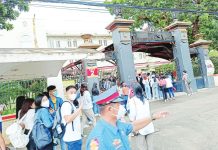 FOOD production is a complete supply chain that starts from growing the raw materials all the way up to the manufacturing process.
FOOD production is a complete supply chain that starts from growing the raw materials all the way up to the manufacturing process.
I would rather adopt this broader meaning rather than just stick to plain and simple agriculture per se.
Admittedly, not all agricultural products would need to be manufactured, but nowadays it is necessary for almost all food items to go through some kind of processing, in order to all more value added to what has been produced.
In the past, packaging or packing might have been unnecessary in many cases, but nowadays, stricter labeling and tracking rules are already being imposed by regional and global trade agreements.
Given the broader scope of the complete supply chain, it would be reasonable to say that the entire chain could be computerized from growing to manufacturing, and the result of that would be the modernization of the entire agriculture industry.
Based on popular practice, computerization is usually followed by automation, and the eventual result of that is modernization. In theory therefore, it is possible to computerize the entire supply chain of food production as a start, subsequently automating it as well, with modernization as a final goal.
While on a trip to Israel many years ago, I was able to observe that entire farmlands over there are networked in such a way that the systems are programmable and addressable. Because of that, the delivery of water, fertilizers and insecticides is fully automated.
It appears that everything that happens in the system is sensor driven, making it a precursor in a way of today’s Internet of Things (IOT). I would not be surprised if the delivery of water is triggered by a sensor that monitors moisture content. Similarly, the delivery of liquid insecticides might also be triggered by a motion detector that activates in case of an insect attack.
I purposely made the point that modern food production should be a complete supply chain, in order to stress the fact that everything within the system could be computerized. I would not be too excited about this reality if I knew that the modern technologies would be beyond the reach of ordinary farmers, but the fact is it is not.
As noted by some technology observers, smartphones are in effect the first genuine IOT devices to come out in the market and that by itself is a clear indication that the costs are affordable. Admittedly, the higher costs would be at the server side, but for all intents and purposes, the costs at the server side could be shouldered by the government or by the cooperatives.
We live in a time wherein ordinary people already own drones that could fly overhead to gather data and take pictures. Not just that, there are balloons that are already out in the market that could also gather data and take pictures. Aside from that, these drones and balloons could also be used for intranet and internet connectivity.
Truth to tell, all kinds of images could be taken, not just ordinary pictures. Imagine what would happen if there are sensors in the sky on board drones and balloons that could collect data, at the same time that there are sensors in the ground that could do the same. Imagine what the Big Data produced by this web of sensors could do for modern agriculture.
As it is now, it is already a foregone conclusion that the internet cloud, Big Data and IOT could also be used for agriculture as these are used for other commercial and industrial applications.
Again, I stressed the supply chain perspective because beyond growing, Information and Communications Technology (ICT) could also be used for drying, sorting, grading, packing and packaging, among other uses. In this sense, Programmable Logic Controllers (PLCs) could be considered part of ICT. For those who are not familiar with it, PLCs could be classified as the high end industrial grade equivalents of Personal Computers (PCs).
Generally speaking, PLCs are used more for manufacturing applications, but in the case of food production, it would be easy to see that the processes would already cross into the manufacturing side after the growing side.
Both ICT and PLCs could also be used for warehousing and inventory management and the latter could involve the use of grain silos, an old technology that is hardly used in this country. Beyond manufacturing, these technologies could also be used for marketing and distribution, the latter already crossing into the use of technologies for logistics.
In theory, ICT is actually a subset of Science & Technology, a derivative so to speak. In that sense, all wisdoms that are applicable to S&T could also be applicable to ICT. For example, we could say that ICT should not be for ICT’s sake alone, in the same way that we say that science should not be for the sake of science alone.
What use would it be if we are using and enjoying science as much as we would like to, but without enjoying as well the benefits that science could give to the economy?
What good would it be if we have S&T and ICT coming out of our ears if we could not tap these to ensure food security in general and to feed our people in particular?
In a manner of speaking, it could be said that hunger and poverty our enemies, and S&T and ICT are our weapons. How I wish I could say that we should just use S&T and ICT for economic prosperity in the long run, for the years to come, but whether we like it or not, we have to defeat poverty first before we tackle prosperity.
We have a war to fight, and we have the weapons to fight this war. What are we waiting for?/PN





